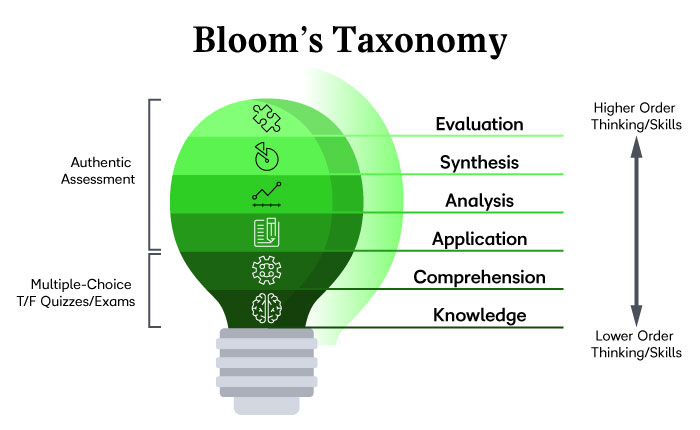Authentic assessments are a great way to engage learners by giving them the opportunity to apply the knowledge and skills they’re gaining to realistic problems. While traditional assessments measure knowledge and comprehension, authentic assessments allow learners to use higher-order thinking skills to demonstrate proficiency.

If you’re new to the concept of authentic assessments, you can explore the topic in more depth in this article . Today we’re going to look at how you can create them using the tools in D2L Brightspace.
Discussions Tool
The Discussions tool is a great place to start because you’re probably already using it—and may even be doing some authentic assessment there.
Discussions can become authentic assessments when they move beyond asking learners to regurgitate information and ask them to apply what they are learning. For instance:
- Ask them to share relevant examples from their personal or professional lives, the media, or even fictional sources like books and movies.
- Keep seeding the conversation with additional challenges that change the situation and require them to answer new questions and solve new problems.
- Case studies are a staple authentic assessment method because they require learners to work through real situations in all their complexity.
- Asking learners to role play by participating in a discussion from a particular point of view is another way to challenge them to think differently about a problem.
Did you know? You can also use the Discussions tool for reflective journaling by setting up private discussions with each learner.
Quiz Tool
Designing authentic assessments in the Quiz tool is straightforward when the quizzes will be graded manually. For instance, case study reports and scenario-based, short-answer questions ask learners to apply what they have learned by explaining the logic behind their answers.
It’s also possible to design auto-graded quizzes to be authentic assessments but it takes a bit more planning to ensure the questions target the higher levels of Bloom’s Taxonomy. A great example of this is the classic word problems from math class—learners read the scenario, have to determine what the question is asking them to do, choose or build the right formula based on the variables, and work out the solution. This style of quizzing can work with any problem that can be broken into a series of questions based on the steps required to solve it.
Another approach could be to ask scenario-based questions but give four similar answers. This will require learners to use their problem-solving skills to examine the details and work out which answer makes the most sense.
Assignments
Any time you ask learners to do an assignment that goes beyond recalling information to apply the skills and knowledge they’re gaining, you’re assessing them authentically. The types of things you ask them to do will depend on what they are learning, of course, but consider:
- hands-on projects
- writing assignments to real audiences rather than generic essays or reports
- compare-and-contrast assignments
- presentations
Advanced Tip: Simulations
Watch Jeff Salin and Ruth Cuthbert demonstrate a simulation they created using Twine and Articulate 360 and imported into Brightspace. This simulation uses branching scenarios to allow learners to experiment and get instant feedback in a fun and risk-free activity.
Video Assignments
Video is one of our favorite tools for creating authentic assessments. As Ruth Cuthbert, a learning experience consultant at D2L, points out:
“The wonderful thing about a video assignment is that not only are you assessing authentically, you’ve just built in practice time because no one does it in the first take. They practice the skill. They practice communication strategy as they fine-tune their wording. The feedback we hear from learners is that they do a lot more prep work when they are recording themselves performing a task because they want to do well in front of everyone else.”
Whether you are using Video Notes throughout the course or the Video Assignment tool, video makes it easy to design tasks that allow learners to demonstrate new skills.
Authentic Assessments Made Even Easier
If you’re looking for new ways to assess learners authentically but want a little help, we’re here for you. Whether it’s for one course or an entire catalog, our instructional designers can help bring your vision to life.
Written by

Karen Karnis has a BA in sociology from the University of Guelph. She has worked in social services, higher education, communications and journalism. Karen is currently working toward a Master of Education in Sustainability, Creativity and Innovation through Cape Breton University.
Stay in the know
Educators and training pros get our insights, tips, and best practices delivered monthly